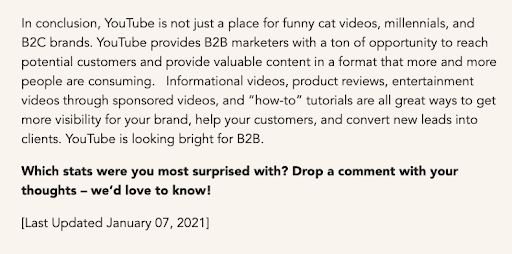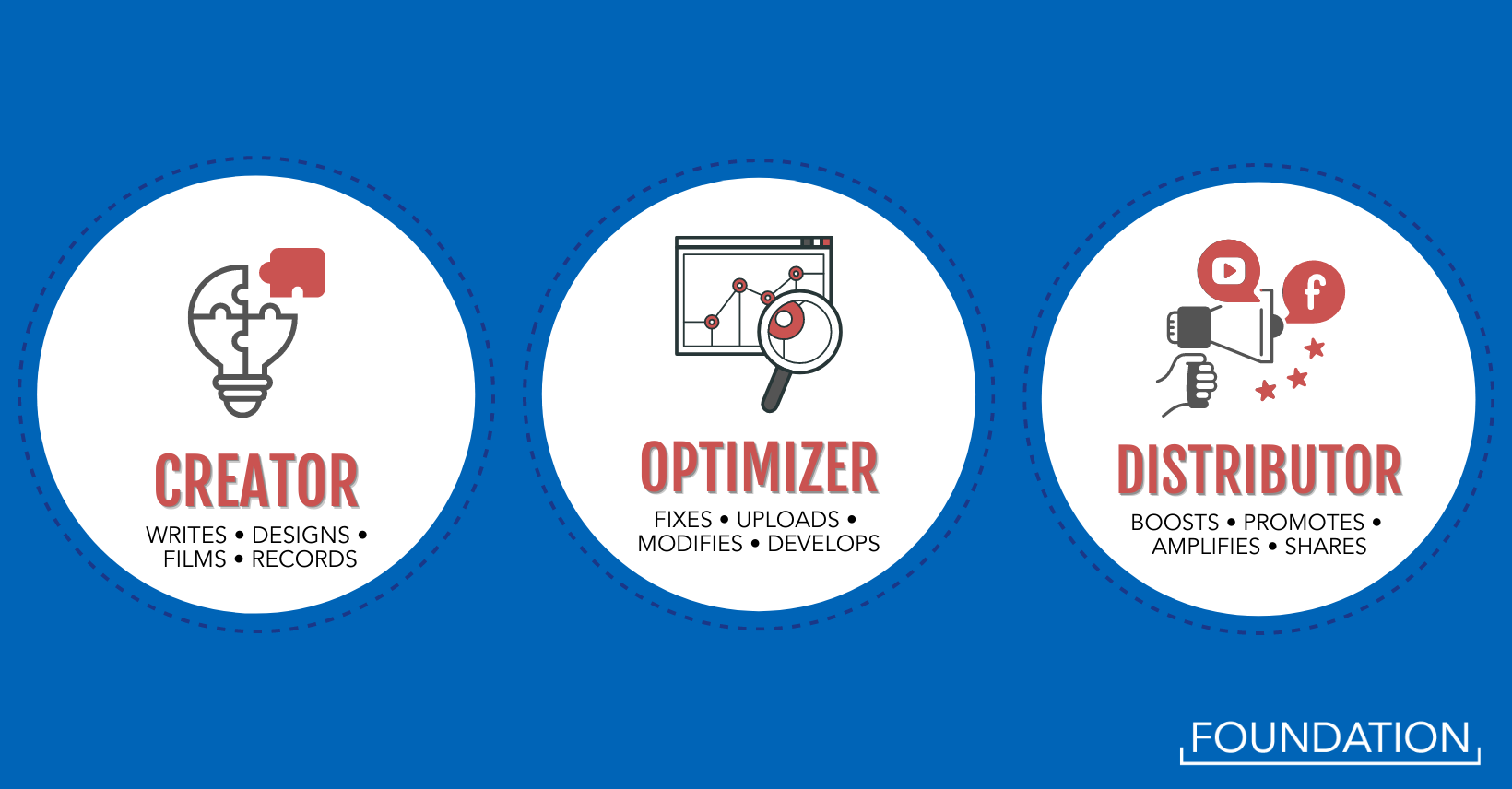Article's Content
Welcome to volume 32!
Last week on the Power + Presence + Position Podcast, Ross Simmonds joined Eleanor Beaton to discuss how to 10X the power of your content marketing.
But two weeks from now, it will be three weeks ago that Ross and Eleanor teamed up to discuss content marketing. The problem with using points of time without proper context is that your content will quickly become deciduous and lose evergreen status 🌲.
Before we get into that, here’s a peek at what’s to come:
- Timestamping blog content benefits your audience
- The three roles every content marketing team needs
- Digital marketing’s future in a cookieless world


Throwback Thursday to this fantastic DGMG podcast episode!
The DGMG Podcast: Ross Simmonds on B2B content, influencer marketing, and social media strategy.
If you missed it on release, back in March 2021, you’re not too late to give it a listen today. Tune in to hear Ross and Dave jam on B2B marketing.
How About a Date?
Collins Opara took to Twitter to source an answer to the burning SEO question: Is removing dates from blog posts better for SEO, or is it better to change the date?
In his typical ambiguous manner, John Mueller came through with his answer – Even when you publish something without a date, Google still keeps time.


John also confirmed that Google does have clocks, and here I was thinking they were using sundials… 😅
All jokes aside, let’s get back to Collins’s question – Do timestamps on blog content matter?
We mere humans can’t fool Google’s computer-based algorithm; it’s able to track publish dates based on bot crawls and keeps track of each crawl date. So no, removing publish dates doesn’t benefit your content in terms of SEO.
By removing the publish date, you are burdening your readers. Your audience is looking for relevant information and will rely on a publish date to determine the ‘freshness’ of your content. If there is no date, they are left wondering if this blog was published in 2005 or 2021.
How many times have you been reading a post, and you come across a line like “last month this happened” or “on Thursday, a press release was published.” Naturally, you’ll need to put these referencing dates in context, but when there is no publication date, you’re SOL.
If you are committed to posting without publish dates, heed my warning: do not reference points in time; state the exact date you are referencing. Otherwise, your content will become quickly irrelevant to your audience, and you can wave 👋 evergreen status goodbye.
Updating publish dates after a modification or including a note in your content saying “updated on [date]” will help your SEO.


Modification dates tell Google’s bots that your content is fresh and that it’s been updated with, hopefully, timely and relevant information. Readers will also benefit from this as they know the content is up to date and refreshed to reflect current information.
Including updated dates in titles and meta-content is also extremely important. At a glance on the SERP, your audience will see that the content is up to date. And we know that Google reads titles and meta-content to judge content.
Without looking it up, tell me which title would rank better in 2021: Need to Know Instagram Stats (2019) or Need to Know Instagram Stats (2021).
Exactly, it’s the latter. For the same reason we know to update our titles and meta-content, we should know to update publication dates and include a call out to when the content was refreshed.
A final note: Stop writing for Google and start writing for your audience! That is the main way to improve your SEO and boost your SERP rankings. Google is concerned with providing the best information, and a piece with outdated information won’t satisfy that goal.
Key Takeaways
- Publish dates aren’t crucial to Google, but they are essential to your audience.
- Refreshing dates based on content modification benefits your audience and Google.
- When updating time-sensitive information, you need to update page titles and meta-content.
3 Roles Every Content Team Needs
There is no such thing as a one size fits all solution. Your content team is going to look different than Hubspot’s team, it’s going to look different from the team at your favourite content marketing agency (Foundation), and that’s okay.
You need to form a team that works with your organizational structure and budget. But, with that said, there are three roles every team NEEDS to have.


A Content Creator writes new blog posts, essays, white papers, landing page copy, and any other content including the written word. But they’re not siloed into writing. The content creator is the person who knows how to develop content worth seeing.
A Content Optimizer is the person who comes in and makes sure that the content is set up to succeed. They add transcriptions to videos, ensure that the written word is optimized with keywords and appropriate headlines, make sure that the YouTube description is optimized, and they ensure interlinking is happening. The content optimizer is the person who knows how to ensure your content is ready to go live and thrive.
A Content Distributor takes charge of the final step in the content marketing process, covering what happens after pressing publish. They take the asset created by the creator and optimized by the optimizer, and ensure it’s spread across the appropriate channels. The content distributor is the person who takes what you created and distributes it forever.
In the early days, before you are able to unlock the true power of specialists, these three skill sets have to be embraced by solo marketers.
There is one additional “man behind the curtain” fourth content marketing team member. To find out what role they take on, check out how to structure a content marketing team that drives results.
Key Takeaways
- Every content marketing team is structured differently.
- There are three non-negotiable content marketing roles.
- You don’t need three people to fill these roles from the start.
Multichannel Marketing in 2022
Cookies have been around since the ’90s, tracking users’ movement across the web. Since that time, Google has been able to monetize through ads based on cookie data.
As of late, there has been a push for a privacy-centric web experience, which means we will be parting with cookies. Google is the last browser to phase them out and will be cookie-less by 2022 and replaced by “group profiling.”
But what does this mean for us digital marketers?!
I’d love to kick this off with a ‘back in my day we didn’t have these “cookies,”’ but sadly, they are all I’ve ever known—placing me in the same boat as most of you who are just as curious as to what this means for the future of digital marketing and PPC ads.
In a cookieless world, we have to go back to the basics in order to master marketing in the digital world. Jay Friedman, president of Goodway Group, had this to say about the future.
“…marketers should look to build a model that goes beyond the medium and the message to match the new reality that digital created, which encompasses audience, medium, moment, mindset and message.”


Taking it back to the basics means starting with audience understanding. You need to know who your audience is inside and out.
Once you have a clear understanding of who your audience is, the following steps are to understand your audience’s behaviour and mindset.
In this digital world, people are engaging and being targeted at different times and in more places than previously possible. From cooking in the kitchen and listening to a podcast to scrolling through Instagram, your audience is accessible.
You need to ask yourself:
🤔 What’s going to grab their attention?
🤔 What are they doing when interacting with your ad?
🤔 Is your ad format optimized for the channel of distribution?
🤔 What action are we looking for them to take, and does that align with the chosen channel?
Marketing has always been centered around the consumer. We just got lost along the way, getting too comfortable optimizing ads for PPC platforms rather than focusing on organic connections and understanding our audience’s user behaviour.
To get you started in reconnecting with your audience, Foundation has this handy downloadable Customer Journey Map.
Key Takeaways
- Going cookie less means focusing back on your audience’s behaviour.
- Understanding and optimizing for your audience is the future for marketing success.
- PPC ad platforms will change, and we won’t need to focus on optimizing for them any longer.
OTHER NEWS OF THE WEEK:
💳 After a $600M fundraising round, Stripe has been on an acquisition rampage. Most recently, it’s acquired Bounder to integrate its card authentication technology into Stripe’s Radar fraud detecting tool.
💻 Jifflenow, a meeting automation platform provider, raised $11.9M in its latest funding round. It plans to use this funding to accelerate product development and expand its marketing and sales efforts.
🤖 Product intelligence software company, Amplitude, has acquired Iteratively, a startup that builds trustworthy data pipelines.
BRAIN FOOD OF THE WEEK:
Tesla better watch out because there’s a new electric kid on the block.
Canoo is coming in, step by step, to compete with Tesla in the electric car market. Canoo’s new all-electric minibus is rolling out in 2022 and is available for pre-order at a non-competitive price of $35,000. By 2023 we can expect new models to be available for pre-order as they begin producing their pickup trucks and delivery vans.
Hold on, because there’s more to Canoo’s story! Hyundai had shown interest in Canoo’s skateboard design architecture, and there were rumors of a partnership. However, Canoo’s new CEO, Tony Aquilla, all but shut it down in March’s investor call. Sorry Hyundai, but whatcha gonna do about it?
TWITTER THREAD OF THE WEEK:
20 ways to promote yourself online by Blake Emal
WHAT WE’RE WIRED INTO THIS WEEK 🎧:
Picture Show by Neon Trees (Best Track: Everybody Talks)
Originally sent out, by me Cali B, on Thursday, May 20, 2021.
Stay up to date with all of our latest findings by subscribing to our newsletter today. Signing up also gives you early access to Ross’ Tuesday essay full of exclusive industry insights.
Quick, do it now before the next drop!







